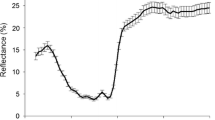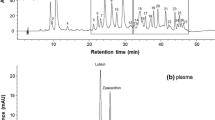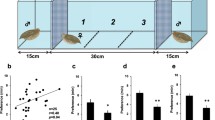Abstract
Despite extensive research, the potential costs that keep secondary sexual traits honest and evolutionary stable remain somewhat elusive. Many carotenoid-based signals are regulated by testosterone (T), which has been suggested to impose a cost to the signaller by suppression of the immune system or an increase in oxidative stress. Results are, however, inconsistent, which may be due to the fact that T can be metabolised to both 5α-dihydrotestosterone (DHT, a potent androgen) and oestradiol (E2, a potent oestrogen). To evaluate for the first time the independent effect of these testosterone metabolites on oxidative status, circulating carotenoids and a carotenoid-dependent sexual signal, we administered DHT and E2 to captive non-breeding adult kestrels Falco tinnunculus of both sexes. E2 increased oxidative damage and downregulated the antioxidant barrier without affecting colouration or circulating carotenoids. In contrast, DHT did not affect oxidative status, but increased skin redness, again without affecting circulating carotenoids. No sex-specific effects were found. These results suggest that the pro-oxidant activity of T could be induced indirectly by its metabolite, E2, whereas the other metabolite, DHT, stimulates signal expression. Finally, the study shows that changes in oxidative damage or antioxidant status of plasma were not correlated with either skin redness or circulating carotenoids.


Similar content being viewed by others
References
Alonso-Alvarez C, Bertrand S, Faivre B, Chastel O, Sorci G (2007) Testosterone and oxidative stress: the oxidation handicap hypothesis. Proc R Soc Lond B 274:819–825
Alonzo-Alvarez C, Pérez-Rodríguez L, Mateo R, Chastel O, Viñuela J (2008) The oxidation handicap hypothesis and the carotenoid allocation trade-off. J Evol Biol 21:1789–1797
Andersson S, Prager M (2006) Quantifying colors. In: Hill GE, McGraw KJ (eds) Bird coloration, mechanisms and measurements, vol. 1. Harvard University, Massachusetts, pp 41–89
Armstrong DG (1984) Ovarian aromatase activity in the domestic fowl (Gallus domesticus). J Endocrinol 100:81–86
Ball GF, Balthazart J (2008) Individual variation and the endocrine regulation of behaviour and physiology in birds: a cellular/molecular perspective. Philos T R Soc Lond B 363:1699–1710
Balthazart J, Ball GF (1998) New insights into the regulation and function of brain estrogen synthase (aromatase). Trends Neurosci 21:243–249
Behl C, Skutella T, Lezoualc’h F, Post A, Widmann M, Newton CJ, Holsboer F (1997) Neuroprotection against oxidative stress by estrogens: structure–activity relationship. Mol Pharmacol 51:535–541
Bertrand S, Faivre B, Sorci G (2006) Do carotenoid-based sexual straits signal the availability of non-pigmentary antioxidant? J Exp Biol 209:4414–4419
Bhat HK, Calaf G, Hei TK, Loya T, Vadgama JV (2003) Critical role of oxidative stress in estrogen-induced carcinogenesis. P Natl Acad Sci USA 100:3913–3918
Blas J, Hiraldo F (2010) Proximate and ultimate factors explaining floating behavior in long-lived birds. Horm Behav 57:169–176
Blas J, Perez-Rodriguez L, Bortolotti GR, Vinuela J, Marchant TA (2006) Testosterone increases bioavailability of carotenoids: insights into the honesty of sexual signalling. P Natl Acad Sci USA 103:18633–18637
Bluhm CK, Phillips RE, Burke WH (1983) Serum levels of luteinizing hormone, prolactin, estradiol and progesterone in laying and non-laying mallards (Anas platyrhynchos). Biol Reprod 28:295–305
Borrás C, Gambini J, Lòpez-Grueso R, Pallardo FV, Vina J (2010) Direct antioxidant and protective effect of estradiol on isolated mitochondria. Biochim Biophys Acta 1802:205–211
Brambilla G, Ballerini A, Civitareale C, Fiori M, Neri B, Cavallina R, Nardoni A et al (2003) Oxidative stress as a bio-marker of estrogen exposure in healthy veal calves. Anal Chim Acta 483:281–288
Buchanan KL, Evans M, Goldsmith AR, Bryant DM, Rowe LV (2001) Testosterone influences basal metabolic rate in male house sparrows: a new cost of dominance signalling? Proc R Soc Lond B 268:1337–1344
Bui Q, Weisz J (1988) Identification of microsomal, organic hydroperoxidedependent catechol estrogen formation: comparison with NADPH-dependent mechanism. Pharmacology 36:356–364
Bunyagidj C, McLachlan JA (1988) Catechol estrogen formation in mouse uterus. J Steroid Biochem 31:795–801
Butler MW, Toomey MB, McGraw K (2011) How many color metrics do we need? Evaluating how different color-scoring procedures explain carotenoid pigment content in avian bare-part and plumage ornaments. Behav Ecol Sociobiol 65:401–413
Calderón Guzmán D, Mejía GB, Vásquez IE, García EH, del Angel DS, Olguín HJ (2005) Effect of testosterone and steroids homologues on indolamines and lipid peroxidation in rat brain. J Steroid Biochem Mol Biol 94:369–373
Carreau S, Genissel C, Bilinska B, Levallet J (1999) Sources of oestrogen in the testis and reproductive tract of the male. Int J Androl 22:211–223
Casagrande S, Groothuis T (2011) The interplay between gonadal steroids and immune defence in affecting a carotenoid-dependent trait. Behav Ecol Sociobiol 65:2007–2019
Casagrande S, Csermely D, Pini E, Bertacche V, Tagliavini J (2006) Skin carotenoid concentration correlates with male hunting skill and territory quality in the kestrel (Falco tinnunculus). J Avian Biol 37:190–196
Casagrande S, Costantini D, Fanfani A, Tagliavini J, Dell’Omo G (2007) Patterns of serum carotenoid accumulation and skin colour variation in kestrel nestlings in relation to breeding conditions and different terms of carotenoid supplementation. J Comp Physiol B 177:237–245
Casagrande S, Costantini D, Tagliavini J, Dell’Omo G (2009) Phenotypic, genetic and environmental causes of variation in yellow skin pigmentation and serum carotenoids in Eurasian kestrel nestlings. Ecol Res 24:273–279
Casagrande S, Dijkstra C, Tagliavini J, Goerlich V, Groothuis T (2011a) Differential effects of testosterone, dihydrotestosterone and estradiol on carotenoid deposition in an avian sexually selected signal. J Comp Physiol A 197:1–13
Casagrande S, Dell’Omo G, Costantini D, Tagliavini J, Groothuis T (2011b) Variation of a carotenoid-based trait in relation to oxidative stress and endocrine status during the breeding season in the Eurasian kestrel: a multi-factorial study. Comp Biochem Physiol A 160:16–26
Cavalieri E, Frenkel K, Liehr JG, Rogan E, Roy D (2000) Estrogens as endogenous genotoxic agents—DNA adducts and mutations. J Natl Canc Inst Monogr 27:75–93
Chapman M (1980) Animal lipoproteins: chemistry, structure, and comparative aspects. J Lipid Res 21:789–853
Cohen AA, McGraw KJ (2009) No simple measures for antioxidant status in birds: complexity in inter- and intraspecific correlations among circulating antioxidant types. Funct Ecol 23:310–320
Commission Internationale de L'Eclairage (1978) CIE. Light as a true visual quantity: Principles of measurement. ISBN: 9783900734473
Costantini D (2008) Oxidative stress in ecology and evolution: lessons from avian studies. Ecol Lett 11:1238–1251
Costantini D, Dell’Omo G (2006) Effects of T-cell-mediated immune response on avian oxidative stress. Comp Biochem Physiol A 145:137–142
Costantini D, Møller AP (2008) Carotenoids are minor antioxidants for birds. Funct Ecol 22:367–370
Costantini D, Casagrande S, De Filippis S, Brambilla G, Fanfani A, Tagliavini J, Dell’Omo G (2006) Correlates of oxidative stress in wild kestrel nestlings (Falco tinnunculus). J Comp Physiol B 176:329–337
Costantini D, Fanfani A, Dell’Omo G (2007a) Carotenoid availability does not limit the capability of nestling kestrels (Falco tinnunculus) to cope with oxidative stress. J Exp Biol 210:1238–1244
Costantini D, Coluzza C, Fanfani A, Dell’Omo G (2007b) Effects of carotenoid supplementation on colour expression, oxidative stress and body mass in rehabilitated captive adult kestrels (Falco tinnunculus). J Comp Physiol B 177:723–731
Costantini D, Rowe M, Butler MW, McGraw KJ (2010) From molecules to living systems: historical and contemporary issues in oxidative stress and antioxidant ecology. Funct Ecol 24:950–959
Cutolo M, Sulli A, Seriolo B, Accardo S, Masi AT (1995) Estrogens, the immune response and autoimmunity. Clin Exp Rheumatol 13:217–226
Dashti N, Kelley J, Thayer R, Ontko J (1983) Concurrent inductions of avian hepatic lipogenesis, plasma lipids, and plasma apolipoprotein B by estrogen. J Lipid Res 24:368–380
Deng YF, Chen XX, Zhou ZL, Hou JF (2010) Letrozole inhibits the osteogenesis of medullary bone in prelay pullets. Poult Sci 89:917–923
Foidart A, Silverin B, Baillien M, Harada N, Balthazart J (1998) Neuroanatomical distribution and variations across the reproductive cycle of aromatase activity and aromatase-immunoreactive cells in the pied flycatcher (Ficedula hypoleuca). Horm Behav 33:180–196
Folstad I, Karter AJ (1992) Parasites, bright males, and the immunocompetence handicap. Am Nat 139:603–622
Fusani L, Van’t Hof T, Hutchison JB, Gahr M (2000) Seasonal expression of androgen receptors, estrogen receptors, and aromatase in the canary brain in relation to circulating androgens and estrogens. J Neurobiol 43:254–268
Fusani L, Hutchison JB, Gahr M (2001) Testosterone regulates the activity and expression of aromatase in the canary neostriatum. J Neurobiol 49:1–8
Fusani L, Metzdorf R, Hutchison JB, Gahr M (2003) Aromatase inhibition affects testosterone-induced masculinization of song and the neural song system in female canaries. J Neurobiol 54:370–379
Gao G, Dalton JT (2007) Ockham’s razor and selective androgen receptor modulators (SARMs): are we overlooking the role of 5α-reductase? Mol Interv 7:10–13
Halifeoglu I, Karatas F, Canatan H, Colak R, Karadas E (2003) Investigation of antioxidant vitamins (A, E and C) and selenium levels in chickens receiving estrogen or testosterone. Cell Biochem Funct 21:133–136
Halliwell B, Gutteridge JMC (2007) Free radicals in biology and medicine, 4th edn. Clarendon, Oxford
Han X, Liehr JG (1994) 8-Hydroxylation of guanine bases in kidney and liver DNA of hamsters treated with estradiol: role of free radicals in estrogen-induced carcinogenesis. Cancer Res 54:5515–5517
Hartley RC, Kennedy MW (2004) Are carotenoids a red herring in sexual display? Trends Ecol Evol 19:353–354
Hau M (2007) Regulation of male traits by testosterone: implications for the evolution of vertebrate life histories. BioEssays 29:133–144
Henderson BE, Feigelson HS (2000) Hormonal carcinogenesis. Carcinogenesis 21:427–433
Hunt K, Wingfield J (2004) Effect of estradiol implants on reproductive behavior of female Lapland longspurs (Calcarius lapponicus). Gen Comp Endocrinol 137:248–262
Hutchison JB, Steimer T, Jaggard P (1986) Effects of photoperiod on formation of oestradiol-17b in the dove brain. J Endocrinol 109:371–377
Isaksson C, Andersson S (2008) Oxidative stress does not influence carotenoid mobilization and plumage pigmentation. Proc R Soc Lond B 275:309–314
Jansson G (1991) Oestrogen-induced enhancement of myeloperoxidase activity in human polymorphonuclear leukocytes—a possible cause of oxidative stress in inflammatory cells. Free Radic Res Com 14:195–208
Karbownik M, Reiter RJ, Burkhardt S, Gitto E, Tan D-X et al (2001) Melatonin attenuates estradiol-induced oxidative damage to DNA: relevance for cancer prevention. Exp Biol Med 226:707–712
Ketterson ED, Nolan V Jr, Sandell M (2005) Testosterone in females: mediator of adaptive traits, constraint on sexual dimorphism, or both? Am Nat 166:S85–S98
Kimball RT (2006) Hormonal control of coloration. In: Hill GE, McGraw KJ (eds) Bird coloration, mechanisms and measurements, vol. 1. Harvard University, Massachusetts, pp 41–89
Kudzma DJ, Swaney JB, Ellis EN (1979) Effect of estrogen administration on the lipoproteins and apoproteins of the chickens. Biochim Biophys Acta 572:257–268
Lessells CM, Boag PT (1987) Unrepeatable repeatabilities: a common mistake? Auk 104:116–121
Levin ER (2005) Integration of the extranuclear and nuclear actions of estrogen. Mol Endocrinol 19:1951–1959
McGraw KJ (2006) Mechanisms of carotenoid-based coloration. In: Hill GE, McGraw KJ (eds) Bird coloration, mechanisms and measurements, vol. 1. Harvard University Press, Massachusetts, pp 41–89
McGraw KJ, Ardia DR (2007) Do carotenoids buffer testosterone-induced immunosuppression? An experimental test in a colourful songbird. Biol Lett 3:375–378
McGraw KJ, Parker RS (2006) A novel lipoprotein-mediated mechanism controlling sexual attractiveness in a colorful songbird. Physiol Behav 87:103–108
McGraw KJ, Correa SM, Adkins-Regan E (2006) Testosterone upregulates lipoprotein status to control sexual attractiveness in a colorful songbird. Behav Ecol Sociobiol 60:117–122
Meijer T, Schwabl H (1989) Hormonal patterns in breeding and non-breeding kestrels, Falco tinnunculus: field and laboratory studies. Gen Comp Endocrinol 74:148–160
Metcalfe NB, Alonso-Alvarez C (2010) Oxidative stress as a life-history constraint: the role of reactive oxygen species in shaping phenotypes from conception to death. Funct Ecol 24:984–996
Mougeot F, Martínez-Padilla J, Webster LMI, Blount JD, Pérez-Rodríguez L, Piertney SB (2009) Honest sexual signalling mediated by parasite and testosterone effects on oxidative balance. Proc R Soc B 276:1093–1100
Noirot IC, Adler HJ, Cornil CA, Harada N, Dooling RJ, Balthazart J, Ball GF (2009) Presence of aromatase and estrogen receptor alpha in the inner ear of zebra finches. Hear Res 252:49–55
Pathak S, Singh R, Verschoyle RD, Greaves P, Farmer PB, Steward WP, Mellon JK, Gescher AJ, Sharma RA (2008) Androgen manipulation alters oxidative DNA adduct levels in androgen-sensitive prostate cancer cells grown in vitro and in vivo. Cancer Lett 261:74–83
Pérez C, Lores M, Velando A (2008) Availability of non pigmentary antioxidant affects red coloration in gulls. Behav Ecol 19:967–973
Pérez-Rodríguez L (2009) Carotenoids in evolutionary ecology: re-evaluating the antioxidant role. BioEssays 31:1116–1126
Pérez-Rodríguez L, Viñuela J (2008) Carotenoid-based bill and eye ring coloration as honest signals of condition: an experimental test in the red-legged partridge (Alectoris rufa). Naturwissenschaften 95:821–830
Razmara A, Ducklesa SP, Krausea DN, Procaccioa V (2007) Estrogen suppresses brain mitochondrial oxidative stress in female and male rats. Brain Res 1176:71–81
Reckelhoff JF (2005) Sex steroids, cardiovascular disease, and hypertension—unanswered questions and some speculations. Hypertension 45:170–174
Rehder NB, Bird DM, Lagute PC (1986) Variations in plasma corticosterone, estrone, estradiol-I7β, and progesterone concentrations with forced renesting, molt, and body weight of captive female American kestrels. Gen Comp Endocrinol 62:386–393
Roberts ML, Buchanan KL, Evans MR (2004) Testing the immunocompetence handicap hypothesis: a review of the evidence. Anim Behav 68:227–239
Roya AK, Lavrovskya Y, Songa CS, Chena S, Junga MH, Velua NK, Bia BY et al (1998) Regulation of androgen action vitamins. Hormones 55:309–332
Schlinger BA, Arnold PA (1991) Brain is the major site of estrogen synthesis in a male songbird. P Natl Acad Sci USA 88:4191–4194
Schlinger BA, Fivizzani AJ, Callard GV (1989) Aromatase, 5-alpha-reductase and 5-beta-deructase in brain, pituitary and skin of the sex-role reversed Wilsons phalarope. J Endocrinol 122:573–581
Sharp PJ, Armstrong DG, Moss R (1986) Changes in aromatase activity in the neuroendocrine tissues of red grouse (Lagopus lagopus scoticus) in relation to the development of long-day refractoriness. J Endocrinol 108:129–135
Siitari H, Alatalo RV, Halme P, Buchanan KL, Kilpimaa J (2007) Color signals in the black grouse (Tetrao tetrix): signal properties and their condition dependency. Am Nat 169:S81–S92
Silverin B (2000) Distribution of aromatase activity in the brain and peripheral tissues of passerine and nonpasserine avian species. Gen Comp Endocrinol 117:34–53
Sipe HJ, Jordan SJ, Hanna PM, Mason RP (1994) The metabolism of 17β-estradiol by lactoperoxidase: a possible source of oxidative stress in breast cancer. Carcinogenesis 15:2637–2643
Soma KK, Bindra RK, Gee J, Wingfield JC, Schlinger BA (1999) Androgen-metabolizing enzymes show region-specific changes across the breeding season in the brain of a wild songbird. J Neurobiol 41:176–188
Somes RG Jr, George FW, Baron J, Noble JF, Wilson JD (1984) Inheritance of the henny-feathering trait of the Sebright bantam chicken. J Hered 75:99–102
Tam NNC, Gao Y, Leung YK, Ho SM (2003) Androgenic regulation of oxidative stress in the rat prostate-involvement of NADH(P)H oxidases and anti-oxidant defence machinery during prostatic involution and regrowth. Am J Pathol 163:2513–2522
Tanabe Y, Saito N, Nakamura T (1986) Ontogenetic steroidogenesis by testes, ovary, and adrenals of embryonic and postembryonic chickens (Gallus domesticus). Gen Comp Endocrinol 63:456–463
Tell LA (1997) Excretion and metabolic fate of radiolabeled estradiol and testosterone in the cockatiel (Nymphicus hollandicus). Zoo Biol 16:505–518
Tramontin AD, Wingfield JC, Brenowitz EA (2003) Androgens and estrogens induce seasonal-like growth of song nuclei in the adult songbird brain. J Neurobiol 57:130–140
Tsang Grunder (1984) Production, clearance rates and metabolic fate of estradiol-17 beta in the plasma of the laying hen. Steroids 43:71–84
van de Crommenacker J, Richardson DS, Koltz AM, Hutchings K, Komdeur J (2012) Parasitic infection and oxidative status are associated and vary with breeding activity in the Seychelles warbler. Proc R Soc Lond B 279:1466–1476
von Schantz T, Bensch S, Grahn M, Hasselquist D, Wittzell H (1999) Good genes, oxidative stress and condition-dependent sexual signals. Proc R Soc Lond B 266:1–12
Weisz J, Bui Q, Roy D, Liehr J (1992) Elevated 4-hydroxylation of estradiol by hamster kidney microsomes: a potential pathway of metabolic activation of estrogens. Endocrinology 131:655–661
Windahl SH, Andersson N, Börjesson AE, Swanson C, Svensson J et al. (2011) Reduced bone mass and muscle strength in male 5α-reductase type 1 inactivated mice. PLoS ONE 6(6):e21402. doi:10.1371/journal.pone.0021402
Zahavi A, Zahavi A (1997) The handicap principle: a missing piece of Darwin’s puzzle. University Press, Oxford
Acknowledgments
We thank Neil Metcalfe for helpful suggestions based on an earlier version of the manuscript, the associate editor and two anonymous reviewers for providing valuable comments that helped us to improve the presentation of our study. We are grateful to Bonnie de Vries for help with hormone assays, to Alberto Fanfani for supporting the cage building, and to Nadia Macciocchi, Fernando and Serena Costantini for logistic support during the study. S.C. was funded by a MarieCurie Fellowship (FP6-MC-EIF-025369-HormColor).
Ethical standards
The study was authorized by the Distrectual Authority of Parma (prot.865/08.03.2006) and by the Superior Institute for Environmental Protection and Research (ISPRAprot.1612/T-A31/01.03.2006).
Author information
Authors and Affiliations
Corresponding author
Additional information
Communicated by J. A. Graves.
Rights and permissions
About this article
Cite this article
Casagrande, S., Costantini, D., Dell’Omo, G. et al. Differential effects of testosterone metabolites oestradiol and dihydrotestosterone on oxidative stress and carotenoid-dependent colour expression in a bird. Behav Ecol Sociobiol 66, 1319–1331 (2012). https://doi.org/10.1007/s00265-012-1387-3
Received:
Revised:
Accepted:
Published:
Issue Date:
DOI: https://doi.org/10.1007/s00265-012-1387-3




